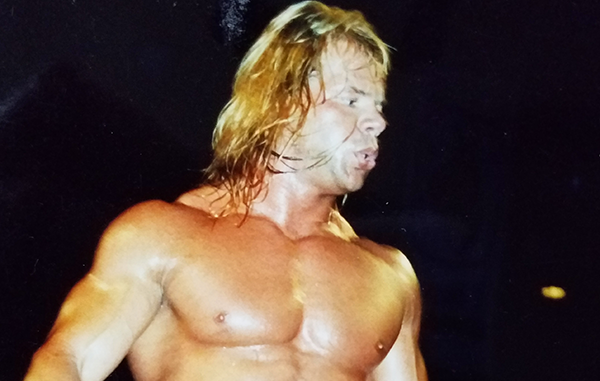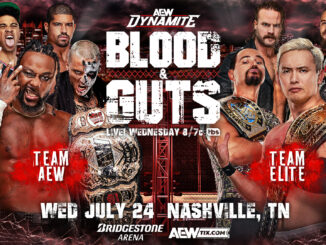
SPOTLIGHTED PODCAST ALERT (YOUR ARTICLE BEGINS A FEW INCHES DOWN)...
WrestleMania 34 is coming up, and being a wrestling fan, I tend to get a little more nostalgic for them olden days of when wrestlers didn’t have scripts with WWE verbage in front of them. DeLorean back to my early days of fandom during the 1990s and you had a product that was hotter than any Seth Rollins theme song (you know, ”Burn It Down?” Okay, I’ll see that bad joke right out the door).
So from now up until “The Grandest Stage of Them All” (with a little help from Wikipedia to fill in the blanks), I will release my Top 50 wrestlers of the 1990s, factoring in their impact from the kid-friendly first half to the cuss-ridden, beer drinking second half to determine where exactly your favorite heel or face fall in rank.
We’re in the Royal Rumble numbers now, starting with who drew number #30, but first, let’s see who drew #50-31
#50. Ken Shamrock
#49. Dean Malenko
#48. Jeff Jarrett
#47. Big Bossman
#46. The Sandman
#45. Davey Boy Smith
#44. The Giant
#43. Taz
#42. Ron Simmons
#41. Rob Van Dam
#40. Eddie Guerrero
#39. Chris Benoit
#38. Sabu
#37. Rey Mysterio, Jr.
#36. Sid Vicious
#35. Kane
#34. Sean Waltman
#33. Chris Jericho
#32. Goldust
#31. Raven
Alright, let’s hit number 30 and hope it’s not received with the reception of Rey Mysterio 2014.
#30: The New Age Outlaws
Hailing From: Orlando, FL (Billy Gunn) & Marietta, GA (Road Dogg)
Finisher: Spike Piledriver
Overall, tag team wrestling wasn’t booked as a popular act in the 90s, but the New Age Outlaws were one of the few to go against the grain. The tandem of Billy Gunn and Road Dogg Jesse James didn’t begin until late 1997. Both were floating in WWF purgatory before that. Billy Gunn was a three-time WWF Tag Team Champion with his brother Bart (keep it kayfabe) as a member of The Smoking Gunns and Road Dogg only had notoriety as a roadie for #48 Jeff Jarrett. All that changed with a change in Attitude.
Billy was floundering with the Honky Tonk Man as Rockabilly and the Road Dog wasn’t even featured on television. Come Shotgun Saturday Night where Honky Tonk accidentally costs Billy a match and it’s on Shotgun Saturday Night (yes, Shotgun Saturday Night) where the hottest tag team during the Attitude Era began.
Who was their first feud? Why not the hottest team of the 80s in the Road Warriors? The act of Hawk & Animal had seen their glory days at this point, but they were still Hawk and Animal and had plenty of rub to give. And to give a young tag team the opportunity to square off against established legends that those spiked-shoulder padded killers is one to take advantage of. The NAO won their first tag straps with nefarious means against the LOD on a November 1997 of Raw.
It wasn’t until right before WrestleMania XIV until the duo joined DX, but it was right in-between a well-constructed story brewing amongst them and the hardcore pairing of Cactus Jack & Terry Funk (but Chainsaw Charlie in this regard).
Some may say otherwise, but pairing the Outlaws with DX added a fresher, brighter paint job to an already hot stable.The forming of factions were the hot thing to do in the later part of the decade, and having a group of unruly outlaws run amok was something to give a dulling product some sharper edges. Heck, from black power groups to biker gangs, when you consider all the gangs running around WWF at the time, building DX up made plenty of sense. Gunn & Road Dogg further established DX with the likes of memorable factions like the Four Horsemen, The Freebirds & the N.W.O.
If we didn’t get the New Age Outlaws, DX wouldn’t be in the conversation of all-time factions (even with the WWF’s uncanny ability for revisionist history). With HBK’s injury, their run would have been a hot one, but not as impactful.
Also, adding them added to Triple H’s star power. He started out as a leader in DX, transitioned that into The Game and eventually found his place as Executive Vice-president of Talent, Live Events and Creative of the entire company. Two words for ya: upward mobility.
I say thank Road Dogg & Billy (again, kayfabe.)
#29: Brian Pillman
Hailing From: Cincinnati, Ohio
Finisher: Air Pillman, Crossbody
Pillman got his wrestling start with Stu Hart & Stampede Wrestling, but his 90’s career kicked off in WCW as Flyin’ Brian. He was NWA Tag champs with the recently passed Tom Zenk and then had feud with Barry Windham under the “mysterious mask” of The Yellow Dog.
He later tag teamed with Windham during his first go as a heel, but then transitioned into his famed run with everybody’s favorite blond in Steve Austin. Both were not from Hollywood and Pillman was dirty blonde at best, but that didn’t stop them from being the best heel tag team of WCW. The two were fantastic as heels and at ring work. Their pairing would foreshadow much bigger things to come.
The two broke up and Pillman eventually joined The Four Horsemen. However, those wild antics went the way of “The Loose Cannon” where he jumped in between the promotions of WCW and ECW. According to Eric Bischoff, he and Pillman had an agreement to do this so it would build Pillman’s wild character, except he played it into getting himself the first-ever guaranteed contract from WWF after eventually being legitimately fired from WCW (before that he was in a real bad car accident that had him on the shelf for a substantial amount of time.)
Pillman played both companies and then he played that into his “loose cannon” character. From New Jack comments to threatening to whip out “his johnson” Pillman brief stay in ECW was controversial with his demeanor and commentary. Bringing that into WWF with his fancy new contract was going to add that edge the company needed to keep up with WCW.
In WWF, he reignited his grudge with Steve Austin in the infamous “Pillman Has A Gun” story and shacked up with Hart Dungeon brethren in the reformed Hart Foundation.
However, like many wrestling tragedies, Pillman suffered from a severe substance abuse problem and it eventually led to him passing in October of 1997.
#28: The Steiner Brothers
Hailing From: Bay City, Mich.
Finisher: Steinerizer
When you factor in what the Steiners did as a tag team and what they later did as single competitors (mostly Scott), they’re absolutely one of the top act of the 1990s.
Rick & Scott started off the decade in the promotion they’re most familiar with in WCW as the NWA Tag Team Champions. Being Michigan wrestling alum, both were athletic and solid in their wrestling style.
They would mix it up with teams like the Freebirds (the Michael Hayes / Ronnie Garvin version), Doom (Ron Simmons & Butch Reed), the Midnight Express (Bobby Eaton & Stan Lane) and even have a run with the IWGP tag straps from Japan. Winning those, the NWA tag titles & the WCW tag titles got them the title of being “Triple Crown Champions”.
The brothers left for WWF in late 1992 after contractual differences and began establishing their act under the lights of Titan Sports. Combining their athleticism with their UM varsity jackets, colorful singlet combos and Rick’s wrestling head gear, the brothers had a way of standing out in the vibrant World Wrestling Federation atmosphere. They’d go on to win the WWF tag belts twice that would give them two PWI Tag Team of the year awards (1990 & 1993).
The Steiners split their decade down the middle with a six-month run in ECW where they were matched up with a lot of the talent on the top 50 list (Guerrero, Raven, Taz, Malenko & Benoit) until they finally made their way back to WCW in 1996.
With the emergence of acts like the nWo & Harlem Heat, Rick & Scott had a fresh new set of adversaries to go against that help establish a credible tag divison for what was becoming a stacked WCW roster.
It was at SuperBrawl VIII where Scott finally double-crossed Rick to join the black & white ranks and then we bid adieu to one of the greatest tag teams in not only the 90s, but all time.
#27: Bam Bam Bigelow
Hailing From: Asbury Park, N.J.
Finisher: Greetings From Asbury Park
What a wild wrestling decade it was for “The Beast From The East”. Aside from a cup of coffee with WCW, Bam Bam started off his 1990s run in Japan, winning the New Japan Tag Team Titles with fellow American monster, Big Van Vader in 1992.
It was in October of that year where he went to WWF. He started off on fire, beating Big Bossman at Royal Rumble 1993, then eventually having memorable matches with Bret Hart. Enter 1994 however and you saw him helping to build acts like Tatanka and being utilized as the heavy in mid-card comedy stints with Doink The Clown.
It wasn’t until got into a shoving match with New York Giants’ Lawrence Taylor is when things began to get interesting for him. Being an excellent worker with the unique look, Bam Bam was the perfect counterpart to compliment a non-wrestler like LT. While Diesel & Shawn Michaels were the official main event for WrestleMania XI, Bam Bam and LT were undoubtedly the true headline.
After a babyface run, Bam Bam eventually left WWF in 1995 to enter the hardcore halls of ECW in Philly. Much like Terry Funk before him, Bam Bam was a big name act that helped to cultivate ECW as a notable brand. Led by Shane Douglas, he and Chris Candido were apart of the heelish Triple Threat faction. Bam Bam eventually broke away from the group to start a brief World Championship reign that had him feuding with Douglas. From there, Bam Bam begun to battle guys like Taz, Sabu, Sandman and Rob Van Dam. Having particularly memorable showdowns with Taz & RVD, Bam Bam elevated their acts that further put the two into wrestling stardom.
In 1998, Bigelow found his was back to World Championship Wrestling where he was immediately thrown into a feud with Goldberg. Eventually he forgettably helped “establish” WCW’s Hardcore division before shacking up with DDP & Kanyon in the heelish New Jersey Triad.
Aside from ECW, Bam Bam was never a consistent top act in WWF or WCW, but he would have his moments in the main events. In a decade that was rife with characters, Bam Bam Bigelow was absolutely one of the biggest, baddest and noteworthy.
#26: Lex Luger
Hailing From: Chicago, Ill.
Finisher: The Torture Rack
Roman Reigns was only one year old when Lex Luger made his pro wrestling debut, but if anybody paved a similar path like WWE’s “Big Dog” it was Lex Luger.
While green in the ring and stilted on the mic, Luger had the look that wrestling promotions would salivate over (plus his pro football background was an added bonus.) He was pushed heavily throughout his tenure in WCW, going onto be a prominent force in the U.S. Title division and eventually found himself in the World Title picture. He was involved with every major act in some form or fashion (which included a run as a member of the Four Horsemen) and it came down to contract disputes that led him to the World Bodybuilding Federation (eeesh) then into the WWF.
Luger started off his WWF run as The Narcissist, where he was managed under Bobby Heenan. Decked out in silver and surrounded by mirrors, The Narcissist was a weird name with just an odd look for guy who could be packaged as something much bigger. Tin foil and tassles just weren’t doing the trick.
Vince found that (or at least thought he did) with Luger as an All-American babyface. He pushed Luger to the moon as the “stars and stripes” donning patriot driving to events cross country in the Lex Express.
But the fans weren’t having it. The demand from the crowd was for Bret Hart and Vince’s foot was light on the gas pedal when it came down to making Luger the face of his company. This lead to the two both winning the 1994 Royal Rumble and them both getting a shot at WrestleMania X against Yokozuna, which Bret ultimately won.
Luger would later tag with Davey Boy Smith for a short stint as “The Allied Powers”, but then Luger’s contract expired and he left for WCW again, unbeknownst to the WWF.
Luger’s surprise appearance on the initial WCW Monday Nitro was the first of many shockers in the infamous Nitro & Raw donnybrook. He’d go heel to join the Dungeon of Doom, then eventually win the tag team titles with Sting before they all began to battle the N.W.O. at Bash at the Beach 1996.
From there, Luger remained a babyface, winning the World Title from Hogan and eventually joining the N.W.O. Wolfpack when the group started showing division in the ranks.
Luger would finish up his ’90s tour with a “Total Package” heel run, but what he’ll be known for was an act that was hot, but never quite as hot as the rest of his main event colleagues.
What do you think of the list so far? Are you “torture racked” with 30-26? How should tag teams count as one induction? Riddle me on Twitter: @DominicDeAngelo and let me have it.
NOW CHECK OUT THE PREVIOUS COLUMN: The Top 50 Wrestlers Of The 1990s (pt. 4) – #35-31: Kane, Raven, Waltman, Jericho, Goldust added to list




No. You can’t put Tag teams as a unit in a listing of “to 50 wrestlers”. It’s a major cop out. The NAO are a great example. Road Dogg has no business on this list as he did almost nothing other than NAO (which was fine but only basically 2 years) and Gunn shouldn’t be this high – on a list of 1990s acts. The ACT was fine if short lived in the 90s. But neither GUY was in context of the decade. Steiners were the same way. they always seemed to be in the #2 promotion and in mid card feuds. Scott took off after he left Rick behind. They just are not close to being equal in total impact for the decade. Pillman was involved in some of the most cringe worth stuff ever in wrestling. Bam Bam was simply a career lower mid carder – but hey he was always around! Luger was impactful for all the wrong reasons. A younger version of Sid. Pushed to the moon everywhere he went and it just never worked out.